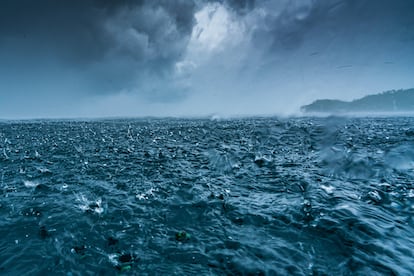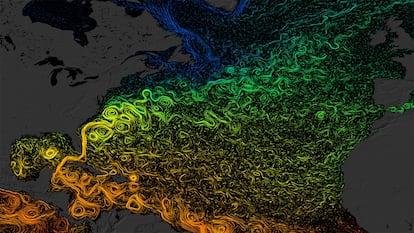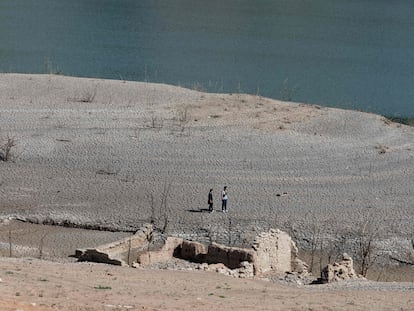The major ocean current that regulates the climate shows signs of collapse
A study suggests that the globally decisive Atlantic water transport mechanism threatens to grind to a halt as a result of the global warming effect of current greenhouse gas emission levels

In 2018, two separate investigations came to the same conclusion: the planet’s circulatory system was weakening. The main set of ocean currents that carry immense amounts of water from tropical to northern seas would be slowing down due to the impact of climate change. The latest UN Intergovernmental Panel on Climate Change (IPCC) report, published this year, reached the same conclusion. But now, a new paper goes further, arguing that the so-called Atlantic Meridional Overturning Circulation (AMOC) will collapse in the coming decades if greenhouse gas emissions are not reduced now. The article even puts the date at around 2057. But other scientists argue that there is not enough data to expect a collapse.
Anyone swimming at the beach these days can get an idea of how the AMOC works. As you go a few meters into the water, you will notice that the shallowest layer is warm, while the deeper layers are colder. In that context, it is because of the direct impact of solar radiation. But on a global scale, the situation is more complex. Equatorial seas are warmer, and the warmer they are, the less dense and heavy the water, which travels to higher latitudes in the form of currents, such as the Gulf Stream. On the way, it tempers the North and South Atlantic and the climate of western Europe and the east coast of the Americas. At the extreme end of this circulatory system, the opposite is true: the colder waters from Arctic zones sink to the bottom and travel to equatorial zones. Despite its name, the AMOC does not stay in the Atlantic. Because of the Pacific and Indian Oceans’ higher relative temperature and salinity, the Atlantic circulation also reaches these oceans. Although its most obvious impact is on the climate, the circulation also affects the distribution of waste and nutrients throughout the world’s seas.
“The AMOC went from a weak state to its current one with the end of the last glaciation 12,000 years ago,” says Susanne Ditlevsen, a mathematician and statistician at the University of Copenhagen (Denmark) and the co-author of the new work on the AMOC’s possible collapse. Twelve millennia ago, climatic conditions changed so much that they also facilitated the great human revolutions that followed: expansion across the planet, agriculture, urbanization.... “The increase in the amount of fresh water [due to melting ice] is slowing down the AMOC, which is slowing down to a weak state,” she adds. While it is cold, arctic freshwater is less dense than saltwater, so it sinks worse, interfering with the circuit. “The problem is evaluating the amount of fresh water,” she says.
For those who have studied the evolution of the AMOC, it is clear that the destabilizing factor is the melting of Greenland and, to a lesser extent, the accelerated loss of Arctic Sea ice, both of which are caused by global warming. However, it is difficult to determine their specific impact on ocean circulation. Direct data on the state of the currents have only been available since 2004, thanks to sensors at depth, buoys and ships. But a 20-year period is too short to differentiate between natural variability and a process caused by human emissions. So, we must look for indirect indicators of the past state of this ocean conveyor belt (thermohaline circulation). Ditlevsen and her brother Peter, a climatologist at the same Danish university, have used North Atlantic Sea surface temperature records spanning almost two centuries to provide a clue.

“There has been a drastic change since the end of the 19th century. Since 1880 and increasingly more each decade, in a situation that cannot be compared with the pre-industrial situation,” says Susanne Ditlevsen, who is affiliated with the Niels Bohr Institute at the same Danish university. Based on these data and using complex statistical tools, the results of the Ditlevsen siblings’ paper — published in Nature Communications — show that the AMOC could collapse long before the end of the century. Their numbers reveal a very high probability that the transition from one state to another would happen around 2057. “I know this is the most controversial part of the paper, and I would like to be wrong. But, if the emissions continue as they are, the results we get are what they are,” Susanne Ditlevsen concludes.
Other scientists’ doubts
Alexander Robinson, an expert in ocean currents at the Institute of Geosciences (IGEO) at the Complutense University of Madrid (Spain), highlights the strengths of this study (in which he has not participated): “They use [new] statistical methods developed to provide early warning signals of when a system could collapse or move to a new state.” According to Robinson, the key — and a possible weakness of this work — is the proxy they have used to view the circulation’s evolution: “To the extent that temperature anomalies in the North Atlantic can be considered a good indicator of the AMOC, this work convincingly shows that a significant change in its state due to global warming is likely to occur this century.”

Climatologist Pablo Ortega has also been studying this current flow for years. His work employs the computing power of the Barcelona Supercomputing Center (Spain). Ortega is one of the researchers whose work detected the Atlantic Ocean current’s weakening in 2018. For years, he has studied what impact the melting of Greenland’s icy masses will have. “Between 2004 and 2012, we detected that it was slowing down,” he says. “But in recent years the trend has not been so clear,” he adds. Ortega believes that the AMOC and its connection to global climate are too complex to determine with projections based on anomalies in the surface temperature of the northern seas. He finds it hard to believe that it will collapse this century.
The scientific information service SMC conducted a round of questions with experts on the Atlantic Ocean current, and there is near unanimity. The Ditlevsen brothers’ work is novel in that it relies on statistical tools rather than climate models. It is also unique in that it detects possible early warning signals that would indicate a change from a strong to a weak AMOC state. But they share Ortega’s view that there is a lot of uncertainty, and that basing the change in ocean circulation on a single indicator is risky. As Penny Holliday, the principal investigator of OSNAP, an international program to study the AMOC, says: “Its collapse would profoundly impact every person on Earth, but this study overstates the probability of it happening in the next few years.”
But they all agree that such a collapse would have global consequences. “The AMOC controls heat transport almost on a planetary scale,” says Ortega. Thus, the end of this thermal partitioning would cool most of the Northern Hemisphere, especially western Europe, and warm the already warm equatorial oceanic portions. Beyond climate, the Atlantic Ocean current is essential for delivering nutrients and sediments that support all the biodiversity that lives in the seas, especially in the Atlantic.
While the following might sound like a climate apocalyptic said it, Hollyday told the British division of SMC that “heat would build up in the Southern [Antarctic] Ocean and South Atlantic, but on the southern continents, temperatures would also decrease. Major rainfall areas would change, leading to much less rain in Europe, North and Central America, North and Central Africa and Asia, and more in the Amazon, Australia and southern Africa. Sea ice would extend southward from the Arctic to the subpolar North Atlantic, and Antarctic Sea ice would extend northward.”
Sign up for our weekly newsletter to get more English-language news coverage from EL PAÍS USA Edition
Tu suscripción se está usando en otro dispositivo
¿Quieres añadir otro usuario a tu suscripción?
Si continúas leyendo en este dispositivo, no se podrá leer en el otro.
FlechaTu suscripción se está usando en otro dispositivo y solo puedes acceder a EL PAÍS desde un dispositivo a la vez.
Si quieres compartir tu cuenta, cambia tu suscripción a la modalidad Premium, así podrás añadir otro usuario. Cada uno accederá con su propia cuenta de email, lo que os permitirá personalizar vuestra experiencia en EL PAÍS.
¿Tienes una suscripción de empresa? Accede aquí para contratar más cuentas.
En el caso de no saber quién está usando tu cuenta, te recomendamos cambiar tu contraseña aquí.
Si decides continuar compartiendo tu cuenta, este mensaje se mostrará en tu dispositivo y en el de la otra persona que está usando tu cuenta de forma indefinida, afectando a tu experiencia de lectura. Puedes consultar aquí los términos y condiciones de la suscripción digital.
More information
Extreme heat: A chronicle of the hottest days on the planet
Últimas noticias
Most viewed
- Alain Aspect, Nobel laureate in physics: ‘Einstein was so smart that he would have had to recognize quantum entanglement’
- Mexico’s missing people crisis casts a shadow over World Cup venue
- Why oil has been at the center of Venezuela-US conflicts for decades
- Trump clarifies who is ultimately in charge in Venezuela: ‘Me’
- Mexico seeks to shore up its defenses following US incursion in Venezuela










































